









 Raleigh’s Village District
Raleigh’s Village District


MEDALLIONS COLLECTION




































 Raleigh’s Village District
Raleigh’s Village District





























53 Mallard Ducks by Terri Kirby Erickson illustration by Jeffery Cates
54 Seeing Art
Marriott Little paints her world by Lori D. R. Wiggins photography by Joshua Steadman
62Music & Movements
Celebrating the unique joys of the Shakori Hills Grassroots Festival by Ayn-Monique Klahre
73 Young Laureates
Work from North Carolina’s first class of Teen Laureates compiled by Jaki Shelton Green illustration by Rebekah Evans
78 Taking Flight
Inside the Living Conservatory, open again at the NCMNS by Hampton Williams Hofer photography by Justin Kase Conder







Ihad this little moment of bliss the other day. It was right after work, which is normally a stressful time (dinner prep, packing gear to drive to music or sports, etc). The kids got home earlier than usual from school and walked in the door just as I was pulling potatoes out of a bag to get dinner started. My 8-yearold, who still loves to help — and now is old enough that she actually can help — offered to peel the potatoes. So I scrubbed them up and she got going. (The going was pretty slow.) I filled a pot of water and got it onto the stove and started to chop the potatoes she’d done so far.
As we stood at the sink, the sun came in low from the big western-facing window. A shaft of light made the steam rising off the water glow. My older daughter came in and noticed the steam, too; she drew a smiley face in the fogged-up microwave over the stove. And there we three were, in the warm, sunny kitchen, keeping our hands busy while my daughters chatted away. I thought, this is good. Soon enough, the moment passed. My younger one got tired of peeling, and I took over. Some hot water splashed out of the pot as the potatoes went in, and my older one made a fuss. Then we hustled out the door for piano lessons.
This month has me reflecting on the emotional rollercoaster of motherhood. I literally swell with pride when one of my daughters nails a piece of music she’s been working hard on — but I hold my breath from the moment she starts until that last note comes in. Most nights, I’m about to burst from frustration after asking the kids to feed the cats or pick up their socks or brush their teeth for the millionth time… but once we’ve turned out the lights and listened to a book together, it’s all but forgotten. I feel it in my gut when they take a nasty tumble, and in my heart when they have a graceful moment on the sports field. Up and down, minute to minute.
Happy Mother’s Day to the moms and mother figures out there who feel the same way.
 Ayn-Monique Klahre Editor
Ayn-Monique Klahre Editor






KOKA BOOTH AMPHITHEATRE, CARY
Editor
MAY 2023
Publisher DAVID WORONOFF
Kids 12 and under admitted free on the lawn!
OPENING NIGHT: MEMORIAL WEEKEND
Tchaikovsky
Symphony No. 5
SAT, MAY 27, 2023 | 8:00 PM
The Music of Whitney Houston
SAT, JUNE 3, 2023 | 8:00 PM
Fire & Rain: Songs of the ’70s
FRI, JUNE 9, 2023 | 8:00 PM
Concert Sponsors: Galloway Ridge, RGA Investments Concert Supporter: York Properties
All Beethoven
SAT, JUNE 10, 2023 | 8:00 PM
A Little Night Music
FRI, JUNE 16, 2023 | 8:00 PM
Classics Under the Stars
SAT, JUNE 17, 2023 | 8:00 PM
Harry Potter vs. Star Wars
SAT, JUNE 24, 2023 | 8:00 PM
NEW! Cirque Cinema
SAT, JULY 1, 2023 | 8:00 PM
Tango Caliente
SAT, JULY 8, 2023 | 8:00 PM
The Catalinas
SUN, JULY 16, 2023 | 8:00 PM
The Symphony will not be performing at this concert. Concert Sponsor: Raleigh Windows & Siding SAVE 25%!
AYN-MONIQUE KLAHRE ayn-monique@waltermagazine.com
Creative Director
LAURA PETRIDES WALL laura@waltermagazine.com
Associate Editor ADDIE LADNER addie@waltermagazine.com
Contributing Writers
Jenn Bianchi, AJ Carr, Wiley Cash, Catherine Currin, Jim Dodson, Mike Dunn, Terri Kirby Erickson, Hampton Williams Hofer, David Menconi, Lori D R. Wiggins
Contributing Poetry Editor Jaki Shelton Green
Contributing Copy Editor Finn Cohen
Contributing Photographers
Mallory Cash, Justin Kase Conder, Tyler Cunningham, Samantha Everette, John Gessner, Eamon Queeney, Matt Ramey, Tim Sayer, Joshua Steadman, Geoff Wood
Contributing Illustrators
Jeffrey Cates, Rebekah Evans, Gerry O’Neill
Interns
Nakya Carter, Emma Deal, Jamaul Moore
Advertising Sales Manager JULIE NICKENS julie@waltermagazine.com
Senior Account Executive & Operations CRISTINA HURLEY cristina@waltermagazine.com
Events Manager KAIT GORMAN kait@waltermagazine.com
Finance STEVE ANDERSON 910-693-2497
Distribution JACK BURTON Inquiries? WALTER OFFICE 984-286-0928
Address all correspondence to: WALTER magazine, 421 Fayetteville Street, Suite 104 Raleigh, N.C. 27601
WALTER is available by paid subscriptions for $25 a year in the United States, as well as select rack and advertiser locations throughout the Triangle. Subscribe online at waltermagazine.com/subscribe
For customer service inquiries, please email us at customerservice@waltermagazine.com or call 818-286-3118.
WALTER does not accept unsolicited manuscripts.
Please contact Ayn-Monique Klahre at ayn-monique@waltermagazine.com for freelance guidelines.
Owners
JACK ANDREWS, FRANK DANIELS III, LEE DIRKS, DAVID WORONOFF In memoriam FRANK DANIELS JR.
© WALTER magazine. All rights reserved. No part of this publication may be reproduced in any form without the express written consent of the copyright owner. Published 12 times a year by The Pilot LLC.






PART OF THE FABRIC OF RALEIGH SINCE 1899
PART OF THE FABRIC OF RALEIGH SINCE 1899
Our patients receive state-of-the-art care in a warm, professional, safe and friendly environment.
Our patients receive state-of-the-art care in a warm, professional, safe and friendly environment. We welcome new patients!
OUR SIGNATURE SERVICES INCLUDE:
OUR SIGNATURE SERVICES INCLUDE:
Comprehensive & Cosmetic Dental Care

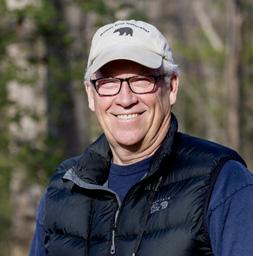
MIKE DUNN / WRITER


Comprehensive & Cosmetic Dental Care
Same-Day CEREC Crowns
Same-Day CEREC Crowns
Suresmile Clear Aligner Orthodontics
Invisalign Orthodontics
Dental Implants
Dental Implants
Sleep Apnea
Sleep Apnea
TMJ Therapy
TMJ Therapy
919-782-0801
919-782-0801
www.drgregweaver.com
wwwdrgregweavercom


We bring special to our specialty store.
On any given day there is something interesting and exciting happening in the Triangle, says photographer Justin Kase Conder. “We live in such a rich community of arts, culture and intellect! This was exemplified photographing both the Shakori Hills Music Fest and then the Living Conservatory at the North Carolina Museum of Natural Sciences. Join me behind the scenes at @JKasePhoto — even after 26 years as a professional photographer, there is always an adventure to be had!”

LORI D. R. WIGGINS / WRITER
Lori D. R. Wiggins was pen-deep into her story about the Diaper Bank of North Carolina when the outreach ministry at her church, St. Ambrose Episcopal Church, announced its Diaper and Period Poverty Drive. The Diaper Bank was a recipient. Her soul smiled! “Alignment,” she thought. Soon after, Wiggins met Raleigh artist Marriott Little, whose life of love and art spans more than nine decades. “She inspires us all to embrace and share our talent, despite age, circumstance or responsibility — and bloom! I hope you enjoy both reads. Learn something. Feel something, too.”
Mike Dunn is a lifelong naturalist educator living on 14 acres of woods in Chatham County. When not chasing chipmunks with a camera for his monthly nature column in WALTER, he enjoys camping, canoeing and observing and sharing the natural world from North Carolina to Yellowstone and beyond. Learn more at roadsendnaturalist.com

As the son of a newspaperman and a teacher, Joshua Steadman inherited a love of learning and telling stories. He believes that both are used in equal measure to do what he does. A commercial and editorial director and photographer, his work has appeared in the Bitter Southerner and Our State. Follow him @steadyfilm. “With Marriott, our bond was quick and electric. When I offered her my arm as we walked to her studio, she squeezed my elbow, gesturing with her other hand for emphasis as she directed my attention to the art on the walls. She was a phenomenal subject; very playful when we asked her to pose half-hidden behind a coffee cup, or with a flower in her hair. After it was all over, she insisted on feeding me a pimento cheese sandwich. When we said goodbye, she hugged me and kissed me on the cheek; I kissed her right back and hugged her tight. It was a great day.”
Many people enjoyed Walter Weekly, the fake magazine we released for April Fools Day.
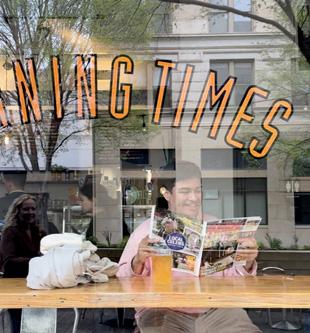
“This is cute except I got real excited about the bbq” — @happedancingyogi
“This is AWESOME! Thx for the hilarious laugh.” — @andreahosborne
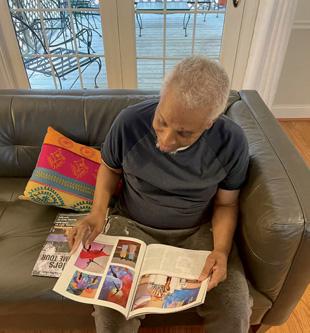
“Thanks again for such a beautiful article. It couldn’t have come at a better time. I have received so many nice comments because you took the time to recognize me.” — Ed
Baxter




Experience a city where all roads lead to spring. Tour heirloom gardens bursting with centuries old blooms. Imagine life at the home of one of America’s first millionaires. Or follow your heart to a living 18th Century Moravian community that’s reinventing how we honor the past. So grab your friends. Hit the road. And see just how far Winston-Salem takes you.
MOUNTAINS + MOSCATO

+ HAPPINESS STORIES + SUNSHINE
Plan your getaway now at
Summer’s almost here! Enjoy the season with independent films, soccer games, outdoor play and tons of live music.
by ADDIE LADNER

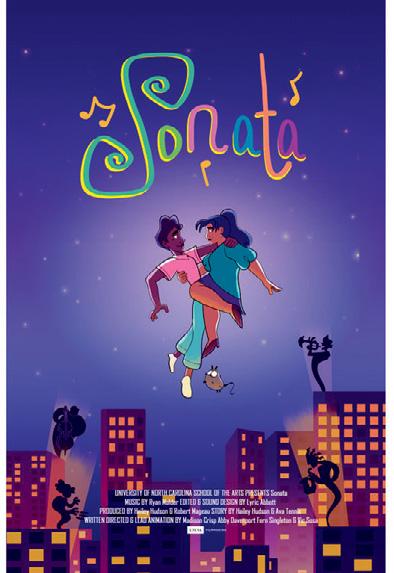

LONGLEAF FILM FESTIVAL
May 12 & 13 | various times
Independent movie buffs will love this free-to-attend film festival that celebrates stories of North Carolina. Longleaf Film Festival will be taking over the plaza outside the North Carolina Museum of History and the museum itself for film screenings (between 60 to 70 total), panel discussions and more. The weekend includes something for everyone, whether you’re an aspiring filmmaker or just love to watch — especially the Movies-N-Moonlight Friday screening, with popcorn and chairs provided. Festival director Sally Causey Bloom is especially excited about this year’s film selection for its wide range of styles, from Ralph Parker’s haunting narrative Sammy Without Strings, about a Black puppet named Sammy seeking freedom, to Addie Navaro’s documentary Down River Jordan, about friends navigating the three countries that border the Jordan River. “We screen movies that entertain, educate and engage —all with a North Carolina connection,” says Bloom. Guests can also enjoy animated shorts like Sonata, a story about a first date; Finding Patience, a musical history of Holly Springs; and How to Survive Your First Date, a dark parody from high school filmmaker Reese Robers.Free; 5 E. Edenton Street; longleaffilmfestival.com
All information is accurate as of press time, but please check waltermagazine.com and the event websites for the latest updates
4–JULY 23, 2023

Michael Richards’s visionary sculptures and drawings, created between 1990 and 2001, engage Blackness, flight, diaspora, spirituality, police brutality, and monuments in his largest retrospective to date.


Michael Richards, Tar Baby vs. St. Sebastian, 1999, resin and steel, H. 90 × W. 36 × D. 24 in., © 2022 The Michael Richards Estate; Photograph by Oriol Tarridas, Courtesy of the Museum of Contemporary Art, North Miami and The Michael Richards Estate
Michael Richards: Are You Down? is co-curated by Alex Fialho and Melissa Levin, and organized by the Museum of Contemporary Art, North Miami. The exhibition is made possible with lead support from Oolite Arts and major support from the Wege Foundation. We are grateful to the Green Family Foundation and Funding Arts Network. Thanks to Brooke Davis Anderson; Roberta Denning; V. Joy Simmons, MD; Miami MoCAAD; and John Shubin for their generosity. Special thanks to Michael Richards’s cousin and steward of his estate, Dawn Dale.
In Raleigh additional support is made possible, in part, by the North Carolina Department of Natural and Cultural Resources; the North Carolina Museum of Art Foundation, Inc.; and the William R. Kenan Jr. Endowment for Educational Exhibitions. Research for this exhibition was made possible by Ann and Jim Goodnight/The Andrew W. Mellon Foundation Fund for Curatorial and Conservation Research and Travel.

May 4 - 7 | Various times
An all-are-welcome, lively weekend-long festival in Pittsboro, the Shakori Hills Grassroots Festival of Music and Dance is worth the hour drive from Raleigh. More than just American folk music, this festival has plenty to explore while you connect with other roots music fans. There’s a huge dance tent, a kids village and a teen outpost, a healing arts village, an advocacy area, camping sites, a number of craft vendors and a sustainability pavilion. This year, in addition to festival regulars like Donna the Buffalo, legendary country star Marty Stuart & His Fabulous Superlatives, bluegrass musician Sierra Hull, and Cuban Afro-punk band Cimafunk will also play. From $57; 1439 Henderson Tanyard Road, Pittsboro; shakorihillsgrassroots.org
May 4 & 18 | 6 p.m.
Hear Piedmont-based roots singer-songwriter Laurelyn Dossett from the lawn at Lake Raleigh for NC State LIVE’s free spring and summer concert series. Gates open at 5 p.m. with food trucks like HotBox Pizza and JAM Ice Cream on site for purchase from. Dossett, who has written for Carolina Chocolate Drops and appeared on NPR’s Prairie Home Companion, will take the stage at 6 p.m. Grab your picnic blanket and lawn chairs and head for Centennial Campus for this free, family-friendly concert set against 75 untouched acres of trails, forest and waterways. Free; 2300 Main Campus Drive; live.arts.ncsu.edu
May 6 | 7 - 11 p.m.
For “Met Gala of Raleigh” vibes, head to the Contemporary Art Museum of Raleigh for Arthouse, a night of cuttingedge art and fun music to help raise funds for the museum and their community programs. Though the tradition has been around for more than a decade, this is its first year back since the pandemic. Enjoy music, performers and
North Carolina’s independent radio channel, That Station, is turning 5 years old! Since its inception, That Station has championed artists from across the state, so it’s fitting that they’ll do the same on May 12 at Lincoln Theatre, throwing an anniversary bash with North Carolina rock band The Nude Party as headliners. “Don’t worry, they all wear clothes now, but when the band started — while its members were at Appalachian State University — they lived up to the name,” says Chris Edge, THAT Station program director. “There’s been a big buzz about this band for a few years now so we’re thrilled that they were available to play and celebrate our anniversary with us. I’m equally as excited about having an opportunity to hang out with supporters of That Station at one of Raleigh’s historic venues.” $20; Lincoln Theatre, 126 E. Cabarrus Street; thatstation.net


food by James Beard award nominee Cheetie Kumar, all while surrounded by the museum’s thought-provoking collections. While not required, Dana Carlsten, CAM’s marketing coordinator says she looks forward to seeing everyone’s creative wardrobes for this art-forward fundraiser and encourages guests to dress to the nines and get ready to dance. “You always see some of the most daring and inventive outfits. Artists and art lovers show off their most spectacular ensembles. Be prepared to showcase your own stunning attire and don’t forget your dancing shoes.” From $250; 409 W. Martin Street; camraleigh.org
May 6 | 11 a.m. - 2 p.m.
Durham-based Big Spoon Roasters, the nut butter and snack bar company, is hosting a Mother’s Day at the company’s new headquarters and production
facility in Hillsborough. Shoppers can sample the entire catalog of Big Spoon Roasters products, from their Carrot Cake Almond and Pistachio Crunch nut butters to their interesting range of snack bars, before building their own gift sets. Be the first to try their latest limited batch: Blueberry Granola Almond Butter, a fruit-forward offering with dried blueberries, toasted macadamia nuts and Vermont maple syrup. Free admission; 500 Meadowlands Drive, Hillsborough; bigspoonroosters.com
May 12 - 14 | Various times Shop vintage clothing, original art, antique homewares and more from vendors from all over the country at Vintage Market Days. Consumable treats will be available from numerous vendors as you shop and enjoy 130-plus unique vendors at this annual event held at the fairgrounds. From $5; NC State Fairgrounds 1025 Blue Ridge Road; vintagemarketdays.com
May 12 | 7 p.m.
Known for her captivating stage presence and supernatural singing voice, Stevie Nicks remains one of the most inspirational women in music history. Famous for solo hits like “Edge of Seventeen” and leading Fleetwood Mac favorites like “Landslide,” “Go Your Own Way” and “The Chain,” Nicks will bring her timeless style, songs and powerhouse vocals to PNC Arena. From $105; 1400 Edwards Mill Road; pncarena.com
May 18 - 21 | Various times
Based on the work of the Brothers Grimm, the world premiere of this ballet was first choreographed in 1890 by Marius Petipa, ballet master of Russia’s Imperial Ballet. Today, Sleeping Beauty is a popular ballet, an emotionally charged interpretation of the classic fairy tale. It will feature live music by The Chamber
May 6 | 10 a.m. - 12 p.m.
The North Carolina Museum of Natural Science’s outdoor oasis, Prairie Ridge Ecostation, is equipped with natural structures for kids to interact with all year, like the wood stage, play kitchen and dirt pit. And this month the museum staff will bring out extra props like capes for roleplay, pots and pans for the kitchen, and chalk for whatever the children dream up. To make a day of it, pack a picnic and take the kids for a stroll along either the Prairie Trail or the Forest Trail. Free; 1671 Gold Star Drive; naturalsciences.org
Orchestra of the Triangle and adapted choreography by Carolina Ballet’s founder Robert Weiss at Raleigh Memorial Auditorium. From $27; 2 E. South Street; carolinaballet.com



May 19 | 7:30 p.m.
Grammy-nominated American roots group The Wood Brothers will take the


stage at NCMA’s amphitheater. Known for their songwriting and storytelling, The Wood Brothers have diverse music and a loyal fan base. Opening the night are Shovels & Rope, a duo from Charleston that blends traditional folk, rock & roll and country together with themes from homelessness to marital strife and social justice. From $45; 2110 Blue Ridge Road; ncartmuseum.org
May 20 & 21 | Various times Head downtown for Raleigh’s longestrunning art festival, a daytime celebration with live music and interactive art. This year, more than 150 juried creators will be showcasing their unique metal works, painting, photography, pottery and jewelry at the Art Market along Fayetteville Street. Little art enthusiasts will enjoy the Kidsplosure component of the event with free hands-on activities. The Sunday headliner will be The Black Opry Revue, a showcase of country music featuring Black artists across blues, folk and Americana genres. Free; Fayetteville Street; raleighartsfestival.com
May 20 | 7 - 9 p.m.
Cheer on the North Carolina Courage at WakeMed Soccer Park for a competitive matchup against the Angel City from California. FanFest starts 90 minutes before kickoff with fun for kids like inflatables, face painting, balloon artists, games and more (it runs during halftime, too). Be on the lookout for new local food and drink options in addition to the classics like popcorn and hog dogs. From $25; 101 Soccer Park Drive, Cary; nccourage.com
May 22 | 8 - 11 p.m.
To the stars! Head to the top of the Durham Hotel, downtown Durham’s boutique Mid-century hotel, for the return of its stargazing series hosted by Morehead Planetarium and Science Center. From the open-air patio with panoramic views of the Bull City skyline, experience telescopic stargazing





DRI has provided state-of-the-art imaging services for nearly 40 years. Now in the Raleigh area, we hope you will let us care for you and your family. We offer immediate appointments and exceptional care in a beautiful, comfortable environment.
CT Scan
X-Ray
MRI
Ultrasound
Cardiac Scoring
Lung Screening
• Virtual Colonoscopy
Wakefield Professional Plaza 11009 Ingleside Place Suite #103, Raleigh 919.521.8311
Hours: Monday–Friday, 8am to 5pm DR I healthgroup.com
with Morehead educators and music from DJ Mic Check, who will be spinning tunes until 10 p.m. Stargazing will take place from 9 p.m. to 11 p.m., but the roof opens at 5 p.m. to kick off the evening with snacks, craft cocktails and sunset views. Free; 315 E. Chapel Hill Street, Durham; thedurham.com
May 22 | 7 - 9 p.m.
Hear fiddle and mandolin players play together at Transfer Co. Food Hall at PineCone’s monthly Bluegrass Jam. In this “circle jam” style, anyone can join in and play their favorite bluegrass instrumentals or vocals. Facilitated by musician Russell Johnson, who leads the bluegrass program at UNC-Chapel Hill, “this is just a fun place where the community can gather to celebrate their love of bluegrass music. Whether you are a player or just a fan, the connections at this jam lead to long-lasting
friendships, growing musical appreciation and a strong sense of community,” says Tray Wellington, PineCone’s communication manager. Get there early to grab a burger from Mama Crows or a bite from Che Empanadas before the music. Free; 500 E. Davie Street; pinecone.org
May 25 | 8:30 p.m.
Grab a blanket and lawn chair and head to the Stephenson Amphitheatre for an outdoor screening of the 2007 blockbuster Transformers. As a part of Raleigh Little Theatre’s Movies in the Garden Series, this May screening will be accompanied by outdoor food trucks from Chick-N-Que, Majestic Ice, JAM Soft Serve Ice Cream and Raleigh Brewing Company. Guests are also welcome to bring their own food and nonalcoholic drinks as they watch Sam Witwicky (Shia LaBeouf) join forces
with the Autobots to save the world. Pay what you can, starting at $1; 301 Pogue Street; raleighlittletheatre.org
May 27 & 28 | Various times
This year at Bennett Place, a historic farmstead dating back to the Civil War, military historians will be discussing what it was like to be an American soldier during that conflict. In April 1865, the two sides met at Bennett Place and signed surrender papers for southern armies in the Carolinas, Georgia and Florida, making it the site of the war’s largest troop surrender of the Civil War. The event is free for children under 5, veterans and active service men and women. $3; 4409 Bennett Memorial Road, Durham; historicsites.nc.gov
































Afew years back, Durham singer/songwriter Skylar Gudasz was grappling with a crisis of faith. Like a lot of musicians, she was sidelined by the pandemic, which left her wondering if she’d have to give up music as a career.
An old blue guitar in her closet, however, had other ideas. Gudasz had inherited the instrument from her brother when he moved to Los Angeles, although it had
mostly stayed in her closet because it was in need of some repairs. But then one day she pulled that guitar out.
“It’s like it brought all these songs on, lined up in a queue above my head,” Gudasz says. “There was a monthlong period when I felt them up there, and all I had to do was pull them out and write them. I’ve experienced songwriting like that, but never a whole group of songs that wanted to be together. It was a super-powerful feeling.”
May 2023 will see the release of the first of those songs, “Mother’s Daughter,” inspired by maternal advice overheard at a friend’s wedding. It sports an ambient electronic pulse that sounds closer to 1980s New Wave than the classic-pop orchestrations of Gudasz’s previous catalog. The rest of this batch of songs should follow later this year as her third full-length album.
Even though they’re still unreleased, these blue-guitar songs have comprised

the bulk of Gudasz’s live set for the past year. Their passions, deep but expressed with elegant understatement (with “fire” as a recurrent motif) have been perfect onstage fodder for her recent “Ask Me Anything” series of shows. In each of these, a trio of local singer/ songwriters — Kate Rhudy, Mipso’s Libby Rodenbough and Gudasz — performs songs interspersed with all three of them entertaining written questions submitted by the audience. It’s equal parts back-porch hootenanny and in-person advice column.
“There have been some questions we’ve refused to answer, because ‘ask me anything’ doesn’t necessarily mean we’ll answer,” Gudasz says. “We get a lot of questions about love, of course, or people asking us to name their animals. It really runs the gamut from silly questions about cheese and jam to talking
about death and loss.”
Now 35, Gudasz grew up in Ashland, Virginia, near the King’s Dominion amusement park. She came to the Triangle to attend the University of North Carolina at Chapel Hill, where she did some of her earliest recording work on other local artists’ records as a flutist (which she still does on a regular basis). But she was already writing her own songs even then.
Gudasz made a stylish debut with 2016’s Oleander, a remarkably mature work showing the influence of Joni Mitchell and Carole King. The album’s best drawing card is Gudasz’s own singing voice, a dusky croon that lands somewhere between Mitchell and Natalie Merchant. That voice keeps her busy as an in-demand backup singer for big-name locals like Hiss Golden Messenger, Tift Merritt, Superchunk and Chris Stamey.
“Vocally, Skylar tends to nail things really quickly,” says Jeff Crawford, one of her regular producers. “That’s not to say it’s easy. But she’s very precise and prepared, wants to get it done just the way she envisions it. We always make sure she gets the right take. She’s extremely professional, but also such a genuine person with so much integrity. Always helpful to everyone who comes her way, and she succeeds at whatever she sets her mind to do.”
Lyrically, Gudasz has a knack for the well-placed epigram, like this line on her new song “Fire Country:” “I tune my guitar to the names of old lovers plastered in posters on the walls.” Between her lyrics, voice and arrangements, Gudasz’s songs can be pretty reverie-inducing — and that goes both ways. “I work incredibly hard at songwriting, but I have to maintain a sense of awe and joy and magic about it, too,” she says.
“A lot of my initial drive to write was because I felt incapable of handling all the emotional feelings about some situations,” she says. “But when things are hard for me, that’s when I have a hard time creating, because all my energy goes toward trying to feel OK. When I’m going through something, the last thing I want to do is that process of writing songs.”
Still, Gudasz keeps enough of an even keel to stay fairly prolific in terms of coming up with new material. It helps to have that old blue guitar, which she says is now hers on “permanent loan.”
“Yeah, my brother has kinda let me have it, even though it’s technically still his,” she says with a laugh. “It was a little busted up, but I was nervous and superstitious about having it worked on. After the record was all done I did finally have it repaired — hesitantly!”

“I work incredibly hard at songwriting, but I have to maintain a sense of awe and joy and magic about it, too.”
— Skylar Gudasz








A closer look at this adorable mammal
words and photographs by
Our home has a lot of windows, so we can look out and watch the goingson of our wild neighbors in the yard. After living on this property for several years, I looked out one morning and saw a brown blur racing from a stone wall to a small footbridge. What was that? It moved so fast as it darted between the plants and under the bridge. In a few seconds, I knew the answer: our first chipmunk! I was hooked — chipmunkwatching can be addicting. A few days later, there were two dashing around the yard and, ever since, I have enjoyed observing their antics as they go about their busy lifestyle. I later learned that a group of chipmunks is called a scurry, an appropriate name for these critters, which I think are the cutest of all our native wildlife species.
Chipmunks are a type of small ground squirrel, measuring only 8 to 10 inches in total length, including about a 4-inch tail. There are over 20 species in the United States, but our only species here in the Piedmont is the Eastern Chipmunk, Tamias striatus. The genus name, Tamias, is Greek for “storer,” and describes their habit of squirreling away large quantities of food in their burrows. The species name, striatus, means “striped,” and refers to their most recognizable physical trait — the alternating dark and light stripes on their cheeks and back. The word chipmunk is from a Native American word meaning “one who descends trees head first.” Though they are ground squirrels, I have witnessed them run up a tree trunk when startled. They also climb to seek nuts or seeds or get a better vantage point to chew on an acorn or scan their territory.
Another notable feature of chipmunks are their expandable cheek pouches, which they can stuff with seeds, nuts, berries and other food. Each pouch has an opening between the jaw and the cheek that can expand to be the size of half a ping-pong ball. I enjoy watching our “chippies” (a word
that I now can’t help calling these little dynamos) run around as they gather nuts and seeds and stuff them in their pouches until their heads are almost three times the original size. Observers have counted as many as 60 sunflower seeds or three acorns being stuffed into one pouch. The quantity they can gather in a short time is impressive. One person recorded a chipmunk hoarding 150 acorns in one day. And famed 19th-century naturalist John Burroughs once observed a chipmunk collect and store 5 quarts of hickory nuts, 2 quarts of chestnuts, and a large amount of shelled corn — almost a bushel of food. The pouches are emptied by squeezing with their front feet. Cheek pouches allow chipmunks to quickly gather large amounts of food in preparation for winter and thereby reduce the amount of time they are out in the open exposed to predators.
Chipmunks always seem to be on the lookout for potential danger — probably because they’re on every predator’s dinner menu (hawks, foxes, coyotes, snakes and free-ranging house cats are local dangers). Chipmunks make warning calls to alert others of the presence of predators. Researchers have discerned three main types of alarm calls given by Eastern Chipmunks: a chip-trill — a short high-pitched call made while running to defend territory or escape predators; a high-frequency chipping call made from a stationary position like a prominent rock or log that indicates a threat from a terrestrial predator; and a lower-frequency chucking call when facing a threat from an aerial predator like a hawk (again made while stationary). The repeated low-pitched clucking note of chipmunks is a woodland sound that fooled me years ago when I first heard it, thinking it was some sort of bird. Now when I hear it, I scan the sky for hawks. Once they are spooked, a chipmunk can disappear in a hurry, scampering to their burrow or other shelter, tail held high.
Chipmunks are most active early in the morning, with another peak in late afternoon. I see them forage all across the yard and nearby woods, but they are particu-

larly fond of the areas around the bird feeders (no surprise there) and the rock walls around our two ponds. They have regular paths they take to and from their burrows as they forage. Burrows can be extensive, especially for the females. A tunnel system can consist of several entrances (a main entrance and some escape exit holes) extending a few feet underground and spanning 10 or more feet in length. They may have multiple underground chambers for different purposes like food storage, raising their young, sleeping or even an outhouse. It can be difficult to find a chipmunk burrow since they usually carry away the excess dirt in their cheek pouches, leaving no obvious mound of dirt at the entrance. Plus, they often disguise their burrow entryways. Two years ago, we started finding 1 ½- to 2-inch holes in our gravel walkway off our deck. One would appear, then get filled in, and another would pop up. We suspected chipmunks, but it wasn’t until I put a trail camera on one of the holes that it was confirmed. A chipmunk was indeed going in and out and would periodically drag leaves, sticks and even rocks over to hide the hole.
The tunnel system is particularly important in winter, when chipmunks go
into torpor, a hibernation-like state of suspended activity with reduced heart rates, body temperature and breathing. Since chipmunks don’t develop a huge layer of body fat like bears do for the winter, they must wake periodically to eat some of their stored food and void waste products. They may stay awake for several days and even wander above ground during warm winter weather. I have even seen chipmunk tracks in the snow in our yard (you remember snow, don’t you?) after a January thaw.
Chipmunks breed in early spring and often again in summer, producing broods of three to five babies. The females nurse their young underground until they venture out after six to eight weeks. I remember seeing the first baby chipmunks in our yard over a decade ago — four bundles of energy about two-thirds the size of the adults, zigzagging everywhere as they chased and tumbled with each other. Soon after, they were on their own, finding new territories and digging their first burrows. Home range is usually pretty small, often only a third of an acre up to about an acre, depending on food availability. Life expectancy in the wild is two to three years.
The distribution of chipmunks in our state is highly variable — some suitable habitats in Wake County have an abundance, others none. Until recently, they were not found in the Coastal Plain, but have shown up in the Wilmington area in recent years (in fact, eight new counties were added to their range in 2021). Found in both urban and rural areas, they prefer open woodlands and forest edges with dry ground for digging their burrows.
Some days I see two or three chippies darting about the yard and it just makes me smile. I know that a few people dislike these little guys as they may steal a snack out of your garden, but, so far, we have lost only a few bites from lowhanging tomatoes and the occasional bean to our chippies. So I, for one, am glad they have decided to chip and cluck in our woods.


The 1968 photo of Freddie and Francis Combs kneeling side-by-side in matching North Carolina State University baseball uniforms might have lost some gloss, but its significance hasn’t dimmed with the passage of time.
More than a prized picture, it symbolizes the fraternal twins’ relationship. Born five minutes apart, they bonded early with brotherly love and a passion for sports, and have remained close for 76 years.
“Inseparable,’’ says Freddie. “It was a blessing having a twin brother and us having a love for sports.”
Spirited, competitive and strong, both were stellar athletes at Hertford’s Perquimans High, participating in


football, basketball, baseball and track.
They both went on to North Carolina State University in 1965 on combination football-baseball scholarships and delivered — Freddie starring in both sports, Francis sparkling in baseball. Both earned degrees, had brief flings as pro athletes and settled in Raleigh. And both succeeded in long sales careers, raised their families and continued fervently backing the Wolfpack.
The Combs’ long tourney started in Perquimans County in the 1940s, where Freddie and Francis embraced sports at an early age. As kids, they would hitchhike to a distant dock, catch a ferry and ride across Croatan Sound to play Little League baseball in Manteo. But when they were 10 years old, their father died suddenly, leaving them heartbroken and
the family financially challenged.
“We had a good mother,’’ Freddie says. “She was a strong Christian and raised us that way. But we grew up poor. We lived off Social Security and what our mother could make as a nurse helping people in their homes.”
Sports became an outlet, a place to excel. In high school, the Combs brothers became double trouble for opponents. Both earned All-Conference honors in football and baseball; Freddie earned prep All-America accolades as a halfback and defensive back.
“Freddie was the better athlete; he was faster, a tough running back, hard to bring down,” Francis says. “I was smarter — not in school, but as a quarterback who called plays, directed the defense and flashed signals as a


catcher in baseball.”
Along with teammate and future Hall of Fame Big League pitcher Jim “Catfish” Hunter, the Combs brothers helped Perquimans win an eastern division football title and state baseball championship. Francis caught, while Freddie and Hunter alternated pitching and playing shortstop.
The brothers encouraged each other and challenged each other. If Freddie didn’t throw strikes, Francis would shout, “Come on! Throw the ball in here!” Freddie shot back: “You don’t ever say that to Catfish!” Francis retorted: “I don’t have too.”
Hunter was dominating, intimidating and caused batters’ knees to shake, Francis says. Freddie wasn’t as overpowering but won the vast majority of his games.
During their senior year, the twins saw their dream of playing college ball become a reality. Several schools expressed interest, but they decided NC State was the best fit for them to stay together and play together. Plus, the school offered both financial aid. “I don’t know how we could have gone to
college without athletic scholarships,” says Freddie.
Ever grateful, Freddie and Francis gave NC State a big return for its investment. Freddie, a defensive back/ return specialist, made first-team All-America and helped the 1967 Wolfpack gain an all-time high No. 3 national football ranking. In the spring, both Freddie and Francis played key roles on the baseball team’s surge to a third-place finish in the 1968 College World Series.
Arriving in Raleigh, the brothers were befriended by NC State sports information director Frank Weedon, who became “like a second father” and helped them settle in away from home. The brothers even lived with him for a short time, and Freddie and Frank wound up in each other’s weddings.
Their athletic career at NC State began on freshman teams, back before first-year athletes were allowed to compete for varsity squads. Francis quarterbacked and Freddie played running back, leading all ACC freshmen in rushing.
A sinewy 165 pounds, Freddie was
physical, elusive, fast. (How fast? Well, he used to catch rabbits for fun around Hertford.) “That ability was God-given,” Freddie says.
Things changed for the Combs after that first year. During the summer Francis traveled with his boyhood buddy Hunter and his Oakland A’s, occasionally pitching to the big leaguers during batting practice.
To Francis’ surprise, the NCAA ruled his participation with the A’s a violation and suspended him from playing sports the fall semester of his sophomore year. So Wolfpack football coach Earle Edwards told him to keep his combo scholarship and specialize in baseball, which he did. (Later, after seeing Francis’ arm strength throwing long passes around the practice field, Edwards reportedly said he wished he had encouraged him to continue playing football as well as baseball.)
Freddie, while a talented halfback, made a position change that same year, switching to defense. Turns out it was a magical move. He earned first-team All-America honors his senior year. He partially satisfied his penchant as a ball carrier by rambling 434 yards on punt returns, setting an NC State career record.
There were many memorable moments, especially in 1967. With a solid offense and defiant defense, NC State started the 1967 football season 8-0 and earned a No. 3 national ranking. The undefeated streak included a win over the highly rated University of Houston Cougars. (They even spoiled the Cougars “victory party” the team had planned before they lost the game: Freddie and some of his Wolfpack teammates, who were staying in a nearby hotel, showed up as uninvited guests.)
A triumph over the No. 2 ranked Pennsylvania State University later in the season could have propelled the Pack to No. 1 in the polls. But undefeated NC State was stopped about a foot shy of the goal line on a late-game drive and lost 13-8. “Absolutely devastating,’’ says Freddie, still feeling the pain of
that defeat 56 years later.
The Wolfpack bounced back from that loss with a prestigious 14-7 win over the University of Georgia in the Liberty Bowl, a perfect ending to a 9-2 season.
In the spring, Freddie and Francis teamed up and helped Coach Sam Esposito’s baseball team win ACC and district titles and make a strong run in the 1968 College World Series, their brightest highlights on the diamond.
Francis was a savvy, strong-armed catcher who masterfully worked with Pack pitchers. Freddie played infield and outfield positions, a baseball bandit who stole bases, and one season posted a team-leading .330 batting average.
Having achieved all that and more, the brothers are known throughout Wolfpack Nation. But Freddie says a lot of people still “don’t know we are twins.” They don’t look like twins, wear matching clothes or make anybody see double. Francis is five minutes older,


taller and bigger than Freddie.
When finishing at State, Freddie was drafted to the NFL by the San Diego Chargers, but got cut in the preseason. He played two and half years for Norfolk, Virginia, in the Continental Football League before suffering a career-ending leg injury.
Francis, who had an unwavering affinity for baseball, spent three seasons in the New York Yankees’ minor-league system.
“Francis was very smart, had an accurate arm, knew how to work pitchers and call pitches,” Freddie says. “If he could have hit better, he might have made it to Triple A, maybe to the majors.”
After their pro playing days ended, when the hurrahs turned to echoes, Francis and Freddie anchored in Raleigh, got jobs, started families and have enjoyed life side by side.
Throughout the ensuing years, they’ve remained tightly tethered to the athletic
program, contributing in various ways.
Francis worked as a “Spotter” with the Wolfpack Radio network for 57 years. During one stretch he attended 598 straight football games, at times having to find a ride. Most memorable is the time he hitchhiked from Raleigh to Michigan, a 30-hour excursion. When he popped into the State dressing room at Ann Arbor, the players gave him a standing ovation. Mercifully, coach Earle Edwards invited him to fly back to Raleigh on the team plane.
Francis and his wife Debbie (whom he met at State, and to whom he’s been married for 52 years), also sent State two talented baseball players — sons Ryan, a pitcher, and Chris, a pitcher, outfielder, first baseman and slugger who blasted 42 career home runs by the late 1990s. After Chris died from ALS at age 45 in 2020, the Wolfpack honored his jersey and established an award bearing his name. “It was a thrill to see my two kids play,”
Francis says. But Chris’ four-year battle against ALS was the “toughest of times.”
These days Francis, who retired after 30 years with Dillon Supply, is officiating area football, basketball and baseball games, working with NC State Radio, attending Bible Study and enjoying family time, especially with grandchildren Ann Marie, Ava and Christopher. Freddie is in his 32nd year selling athletic equipment for Blankenship & Associates. He stays fit by working out and playing pickleball and also values family time. He and his wife Jaime, have been married for 54 years. They keep up with their daughter Kristen, grandson Quinn, and granddaughter Kahlee (each athletic in different ways).
And of course, they remain in close touch. “We talk every week,” says Francis, adding that Freddie “is always available anytime I need something, he’s always there for me — in good times and bad times.”



Once a week, every week, for a few hours each time, Kathy Hohneker heads to a cold but vibrant 12,000-squarefoot warehouse in Durham. There, she packages up diapers, sanitary napkins, panty liners, tampons and adult diapers into bundles of 10 or 25, to be added to packages of other necessities. It’s a neighborship that this retired nurse has practiced for six years and counting,
ever since she learned about the Diaper Bank of North Carolina at an event in Fayetteville. “After I retired, I wanted to continue to serve my community,” says Hohneker. “This serves a very important need — it’s my way to give back and help my neighbors.”
The Diaper Bank of North Carolina is a portal for diaper distribution into homes and onto babies’ bottoms, as well as for personal hygiene items for teens, women and seniors. It was founded by
Michelle Old in 2013. That was the year she adopted her youngest son. “When he came to us at one day old, he was very sick,” she says. “His body could not fight infections.” That meant frequent diaper rashes and other infections, hospital stays and 30 to 40 diaper changes a day. Those costs added up quickly.
Old had previously worked for the North Carolina Coalition Against Sexual Assault and as a legal advocate for the Durham Crisis Response Center.
Her diaper bills made her reflect on the women she’d met through work, many of whom had far less means than she. “I thought, How do families manage this? ” Old says. “No family should have to struggle for basic hygiene items.”
The National Diaper Bank Network says that a healthy baby goes through six to 10 disposable diapers each day, which costs an estimated $70 to $80 per month. But diapers aren’t covered by federally funded health and nutrition programs. Old learned one in three families can’t afford enough diapers, forcing them to use only one diaper all day or to reuse diapers, making children prone to everything from diaper rashes and chafing to yeast and bladder infections due to long-term exposure to toxins from their own waste. Parents can miss work or school if they don’t have diapers to provide to daycare, and they experience stress and depression and shame. “If a person cannot afford food, they can’t afford hygiene items,” Old says. “Parents are making really tough decisions they shouldn’t have to make.”
Old formed the Diaper Bank with a goal to provide 50,000 diapers in her community within a year. Now, the Diaper Bank has distributed more than 23 million diapers statewide with branches in the Triangle, Triad, lower Cape Fear and Charlotte. Diapers are distributed three ways: through open partnership (providing diapers to anyone who goes to a partner agency for them); closed partnership (with availability only to the clients of partner agencies); and by way of its Mobile Diaper Bank, a program that takes diapers by van to high-need neighborhoods. With the three systems combined, the organization serves a total of 50 North
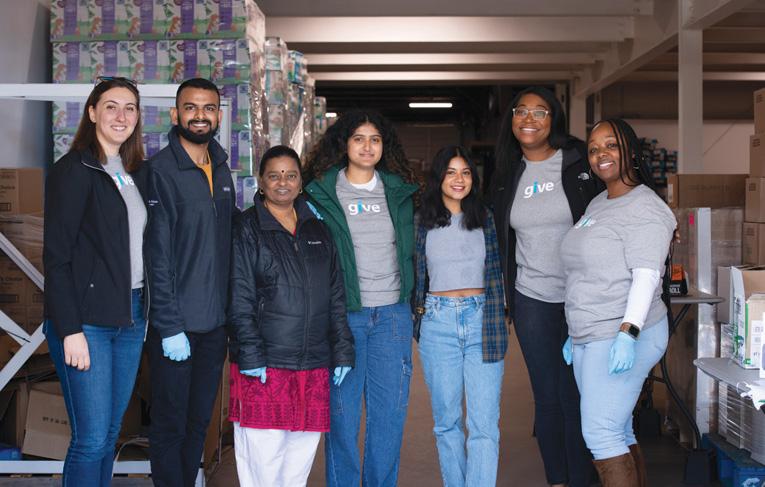
Carolina counties. “We are one of the largest diaper banks in the country,” says Old, who has co-authored articles about diaper needs to fill the void of published research on her work.
“If a person cannot afford food, they can’t afford hygiene items. Parents are making really tough decisions they shouldn’t have to make.”
— Michelle Old
Last year, the Diaper Bank distributed over 3 million diapers through social service agencies like Oak City Cares, Catholic Charities, Brown Bag Ministries, Step Up Ministry and others that serve families and women with children. This year’s target: 7.5 million. Depending on the region, that’s between about 50 to 200 diapers to each location per month, she estimates. On average each month, the Diaper Bank provides 50 diapers per child, 20 sanitary items per woman, and 30 incontinence items per person. Old says it’s a formula based on research that shows families in need lack about 12 diapers per week. “We can’t provide all the diapers they need, but we can help,” Old says. “We can fill the gap.”
In 2014, Old added period products to the Diaper Bank’s distribution. She’d heard from middle- and high-school teachers about students who would miss school because they didn’t have supplies they needed to care for their menstruation. “No one should have to miss school because they’re having a period,” Old says. She also created Period Power, a school-based program to encourage student-led drives for period products and distribution. The Diaper Bank is now helping provide pads, panty liners and tampons to over 200 schools in 40 North Carolina counties. The Diaper Bank has also started distributing incontinence supplies, helping seniors stay dry and healthy, too. “Our work is about distributing dignity in all seasons of life,” Old says.
The Diaper Bank gets a majority of its supplies through donations from drives by community organizations and churches, as well as from financial contributions from individuals, foundations and grants. Even so, the demand can outpace projections. Last year, for example, Old says the projected budget was $65,000. The Diaper Bank spent $365,000, but donations were able to cover the difference.
Like many organizations, the pandemic tested the Diaper Bank’s value and viability. Since the pandemic, Old says, there has been a 400% increase in diaper requests and an 800% increase in requests for period products. Requests for incontinence supplies have also risen 2,000%. “It’s a blanket increase of need, not a certain area or region,” she says. “I’m so proud of my team: We have not missed one distribution.”
Hohneker helped. She stopped by the Diaper Bank several times a month during the first year of the pandemic when it was closed for volunteer work to pick up supplies. At home, she repackaged boxes of 150 diapers to bundles of 25, wrapped them in plastic and dropped them back off at the warehouse. Another couple, both of whom volunteer for the organization, together wrapped 455,000 diapers at home during the pandemic, Old says.
“Volunteers and staff turned their homes into wrapping centers,” she said. “It changed the whole way we served the community at that time.”
Welcome Baby, an organization that supports expecting mothers and parents of young children, was the first community organization to partner with the Diaper Bank as a distribution site. “If the Diaper Bank were not around, there would be a lot less diapers for us to distribute,” says its program coordinator, Patience Mukelabai. “Welcome Baby also distributes feminine products, diaper cream, baby shampoo and sometimes formula,” she says. “We are able to more efficiently serve our families because we can count on the Diaper Bank to have the supplies we need.”
Studies show easing financial stress in just this one area helps in myriad ways. It boosts parents’ mental and emotional health, which leads to increased communication with partner agencies.
That allows those partner agencies to give clients even more support around jobs, parenting skills, housing and other community resources. “The relationship we have with the Diaper Bank has been really beneficial to our families,” Mukelabai adds. “It helps us take away the headaches.”
Old is ready for growth — she’s working toward moving into a larger warehouse and adding full-time staffers to the team. She’s grateful for a “steady” pool of 400 to 600 volunteers that support the Diaper Bank. Hohneker credits Old along with the dedication and kindness of her team for keeping herself and other volunteers involved. “I credit the Diaper Bank for its vision, and it’s really easy to commit to going back,” Hohneker says. “The more we can help people, the more they are able to live a fuller life.”
“Thankfully, people love wrapping diapers,” Old says.















Cue the moody red lights as lanterns and plants hang from above. Friends, old and new, are tucked into cozy booths among funky murals sipping on cocktails, mocktails and Modelos. An eclectic mix of Raleighites dance under twinkle lights on stage, with local DJs dictating the vibe.
Chances are, if you’ve lived in Raleigh long enough, you’ve danced into the night at Neptunes Parlour — even if not in this latest incarnation. The beloved underground bar on Martin Street was
originally opened by husband-and-wife duo Cheetie Kumar and Paul Siler. It was a favorite venue that secured national and even international touring acts from jazz to local punk bands and even comedy acts. Today, it’s helmed by another husbandand-wife duo, Martin and Erin Wheeler, who reopened Neptunes late last year to much excitement from locals who’d been missing its subterranean scene.
Kumar and Siler secured the lease for Neptunes in 2010, along with the spaces for live music venue Kings and Kumar’s acclaimed Garland restaurant,
which closed last year. Kumar took the lead to perfect the space at Neptunes, from the dim lighting on the dance floor to the creative cocktail menu using local products, produce and ingredients (she jokes that her extensive cocktail menu was the product of a frustrated chef). “We envisioned this place as your parent’s basement when they’re out of town,” says Kumar, noting that initially, they had a DJ in-house every night to play vinyl. And it was the most coveted party in town. Lines wrapped Martin Street to get into Neptunes on a Friday

or Saturday night. The mentality “dance like nobody’s watching” was manifested under the lights. It was — and still is — an anytime place for just about anyone, just as Kumar and Siler had hoped it would be.
When COVID-19 hit, Neptunes closed its doors and Kumar and Siler struggled to find the right timing and circumstances to reopen. “As an indoor, underground bar, we were particularly cautious,” says Siler.
Post-pandemic, as Kumar and Siler were moving on to new ventures (the two are planning to open a new restaurant concept on Bickett Boulevard soon), they wanted the right person to transfer management. Enter the Wheelers. “Since the day we met, this is something we’d wanted to do,” says Erin, who works as a real estate agent. “With Martin’s background in hospitality, it was a no-brainer.”

Martin has managed bars for more than a decade across town, including Locals Oyster Bar and Standard Beer + Food. The couple had heard rumblings that Neptunes was for sale and felt it could be the perfect fit. Siler and Kumar agreed. “Erin and Martin are perfect,” Siler says. “They’re about the same age we were when we started this. They’re mature and experienced, but also still young and have the excitement and enthusiasm needed to run a bar like Neptunes.”
“Erin was eating at Garland during its last week in operation,” says Siler. “I had heard she might be interested and asked her in passing — she lit up. We set a meeting for the following week.” Erin and Martin got to work in August and soft-opened Neptunes by December.
The two say it was obvious to them that almost everything would stay the same conceptually. “This place was such a gem,” says Erin. “It needed to be reopened.”
Martin says cocktails will stay balanced and delicious, but he’s curated a smaller menu and he’s batching ingredients to cut down on the time it takes to make them so people can get back onto the dance floor. “The goal is speed and efficiency but flavors that work well together,” he says. “Nothing is too sweet or too tart, plus everyone is using the same recipes. Consistency is our thing.” While drinks may take less time, there’s no cutting corners when it comes to quality and taste. Try a tequila-grenadine-lime Mexican Firing Squad or the, Mambo Sun, made with homemade grenadine and mezcal. There are also delicious craft mocktails with just as much depth of flavor.
Today, there’s still music every night, even if it’s more likely to be a DJ than someone sharing their favorite vinyl. But the sentiment is the same: a judgment-free space to have a drink, dance if you’re feeling it and listen to good music.

INGREDIENTS
2 ¾ ounces lime
1 ounce pineapple
¾ ounce grenadine
1 ounce pineapple rum
½ ounce mezcal
Splash of club soda Orange wedge
DIRECTIONS
Shake, strain and serve over ice in a Collins glass rimmed with Tajin, salt and an orange wedge for garnish.
Kumar and Siler believe the concept has held up. “I love Neptunes,” Kumar says. “It’s a really fun, welcoming space. And it’s dark in all the right ways.” The Wheelers say it’s an honor to take this cherished watering hole into its next phase, which might include karaoke and more comedy nights in the coming months.
“It means the world that they trusted us to take this over,” says Erin. And that safe, welcoming place remains as Siler and Kumar intended. The Wheelers hope you’ll come for an after-work happy hour, a pre-dinner drink, or to dance well into the morning. “It has been amazing to see the community be so supportive through all of this,” says Martin. “Neptunes is such an interesting space that’s so many different things for different people throughout the day.”









Silver Alert is Lee Smith’s 15th novel, and, if you believe her, it’ll probably be her last. How can this be true? How can the writer who gave us Ivy Rowe of Fair and Tender Ladies and the Cantrell family from Oral History be done with crafting memorable characters with expansive histories?
If it is indeed Smith’s last novel, then at least readers will be left with several new characters to remember. There’s Dee Dee, a buoyant, young aesthetician under an assumed name who’s in Key West to hide from a past she can’t shake. There’s her client Susan, a wealthy woman who seems too young to be locked in the throes of dementia. And then there’s Susan’s husband Herb,
a tough old guy from up north who, with his swollen prostate and weak bladder, can’t help but long for the days of his youth. Silver Alert is everything readers want from good storytelling and sharply drawn characters; the book is alternately hilarious and heartbreaking, wise and lighthearted, sly and deeply profound. It’s the kind of novel that only Smith could write, and it will remind readers to be thankful that she has given us so many.
The idea behind Silver Alert came to Smith a little differently than the ideas that spawned her previous novels. Several years ago, when she and her husband, writer Hal Crowther, were driving back from a winter vacation in Key West, they began
“I write my fiction very much from real life. And so, when I had those closer ties to the mountains, that’s what I wrote about. And some of the other places I’ve lived since then that have interested me.”
— Lee Smith

spotting signs on U.S. Highway 1, alerting readers with the words “silver alert,” complete with the make and model of a vehicle. Neither Smith nor Crowther had ever heard of a silver alert, but they’d seen amber alerts that are issued when a youth goes missing, and they soon pieced it all together. They pieced together a story, too.
“We decided that it was an elderly guy who found a set of car keys in an old golf shoe, and he’d taken off in his car with the mani-pedi girl from the assisted living place,” says Smith. She and Crowther had a few laughs on their drive home, speculating about where the man would stop on a trip that might end up being his final burst of freedom.
“There’s never been a more natural plot,” says Smith. “That’s the number-one plot in literature: ‘Somebody takes a trip.’ And number two is ‘a stranger came to town.’”
Her character Dee Dee is from the mountains of North Carolina, and her cheerful beauty belies the dark secrets of a life of poverty that has been suffered in the shadows of sex trafficking. Dee Dee seems to be the only person who can settle Susan during her bouts of confusion, a continuous struggle that has overwhelmed Herb, whose existential angst is fueled by grieving for his wife and the sense that their life together is over.
“Bless her soul,” Herb thinks on the novel’s opening page, “and damn it all to hell.”
Herb’s sarcasm and cynical nature, especially after his and Susan’s kids stage an intervention and force the couple into
selling their home to move into an assisted living facility, could have easily soured the reader’s soul — at one point the narrator even says that Herb “hates everybody that’s young, everybody that’s having fun” — but Smith doesn’t allow that to happen because soon even Herb is buoyed by Dee Dee’s infectious optimism, and it’s that optimism that inspires Herb to abscond with his yellow Porsche, Dee Dee riding shotgun.
I ask Smith how she so convincingly wrote a character like Dee Dee, someone who maintains her spirit in spite of the trauma and struggle in her past.
“Well, I think in part that is a form of self-defense,” she says. “It’s a way of putting a little shell around yourself.”
In the novel, Dee Dee has spent time at the fictional Rainbow Farm in northern Florida, which is a home for women who are hoping to escape life on the streets. It’s the kind of place that Smith knows pretty well after working with organizations like Thistle Farms outside of Nashville, Tennessee. According to the organization’s mission, it’s a “nonprofit social enterprise dedicated to helping women survivors recover and heal from prostitution, trafficking, and addiction” by offering a place to live and the opportunity to learn a professional skill. While at Rainbow Farm, Dee Dee learned to be an aesthetician, something that felt natural to Smith, who admits, “I love the beauty shop type of stuff.”
Dee Dee’s work and her relationships with new friends like Susan and Herb lead her to believe that the terrible fates of life
are far behind her and getting farther away every day, even if they do still exist somewhere in her past. Throughout the novel, Smith brings the reader’s attention to this time continuum, including one moment when Dee Dee is watching moonlight move across a deck, thinking, “I am happy I’m so happy I will remember this for the rest of my life.” The book’s narrator steps in at that moment to add, “and she would, too.”
If Dee Dee is living in the moment while thinking about the future, Herb is living in the past while dreading what’s ahead. While he attempts to care for Susan, he continually “feels himself slipping back, back, back through time” to his first love, a woman named Roxana who he met when they were children in Buffalo, New York.
Given Susan and Herb’s predicament of being forced into assisted living, it would be easy to read Silver Alert as a kind of elegy to aging, but I read it as the opposite. I read it as a celebration of life along the time continuum. It’s about the past, present and future existing in the space of our minds regardless of what our bodies are doing.
“I find incredible solace in that,” I tell Smith.
“Yes,” she says. “Here I am, almost 80 years old, and I think this might very well be the last novel I write. But I still have everything existing in me, all these ideas and memories are still there. You can do that with a novel.”
She continues, “Things are sort of coming to me now in smaller scenes and short stories, smaller things like beads on a string, and you can see that in this book.”
If you were to look back over the novels that Smith has published, beginning with her debut The Last Day the Dogbushes Bloomed in 1968, you could see the beads on a string, the long continuum that has taken her from her hometown of Grundy in the Virginia mountains down to Hillsborough, North Carolina, and various parts of the state where she’s lived and worked.
“In your early work, it seems that you were investigating and chronicling the place that you came from in southwest Virginia,” I say. “And then in your more recent work, maybe beginning with Guests on Earth and Silver Alert, it feels like you’re investigating your place in the larger world after leaving the mountains of your youth.”
“I think that’s true,” Smith says.
“As you’ve spent more time writing about life outside of the place you call home, do you feel your work is somehow getting more personal?” I ask.
“In a funny way, yes, I think so,” she says. “I write my fiction very much from real life. And so, when I had those closer ties to the mountains, that’s what I wrote about. And some of the other places I’ve lived since then that have interested me.”
Beads on a string. The long continuum. Grundy, Hillsborough, Key West and the incredible characters and stories born from these places. It’s all there in Lee Smith’s novels, and regardless of whether or not she ever writes another one, it always will be.




While his azaleas are long gone, the legend lives onby JIM DODSON illustration by GERRY O’NEILL

As spring broke this year, I had a startling realization. I may be turning into Cadillac Joe.
Cadillac Joe’s real name was Joe Franks. He and his delightful wife, Ginny, and their two boys, Joe Jr. and Chuck, lived across the street in the neighborhood where I grew up. I was good friends with the Franks boys. My mom was one of Ginny’s closest chums.
Joe was a highly respected lawyer in town, though that’s not what made him something of a local legend.
Every spring, the Franks family lawn burst spectacularly into bloom with luscious beds of mature azalea bushes
Joe had planted and groomed. During the peak blooming stage, usually around Easter, a constant stream of cars cruised slowly past his house just to take in the impressive floral show — rather like people do at Christmastime to look at over-the-top lighting displays. And thanks to several hundred pink and white dogwood trees that bloomed along the street just as the Franks’ yard exploded in color, Dogwood Drive lived up to its name, including a magnificent Cherokee Brave (pink) and Cherokee Princess (white) that proudly stood for more than half a century.
Over the years, our street — and the Franks house in particular — found
their way into numerous newspaper feature sections and a host of top gardening magazines, including a couple of big spreads in Southern Living.
But what really made the show was that most Sunday mornings throughout spring and summer, Big Joe Franks lovingly washed or waxed his Cadillac in the Franks family driveway while playing Frank Sinatra. His neighbors must have been fans of Ol’ Blue Eyes because nobody I know of ever complained. My mom even took to calling him Cadillac Joe. Looking back, I’m half convinced Cadillac Joe is the reason I have a thing for Sinatra today.
“Dad sure loved that Cadillac and his
azaleas,” Joe Jr. confirmed with a booming laugh when I tracked him down by phone. “And, of course, Sinatra. That was the music of his life. Waxing that Cadillac and growing those azaleas were his passions.”
Joe, the son, is something of a legend, too. He grew up to become a beloved athletic trainer and successful men’s football and women’s golf coach at Grimsley High School in Greensboro. The playing field at Jamieson Stadium is named for “Little Joe Franks,” as my mom called him. Today, Little Joe is semiretired and lives in Danville, Virginia, where his wife, Dr. Tiffany McKillip Franks, is in her 14th year as president of Averett University.
“How’re your azaleas doing?” I asked.
“The college has plenty of them. I don’t have my dad’s thing for growing them, but I do have a Cadillac Escalade just like Dad.”
I wondered if Joe had any idea how many azalea bushes his dad, who passed away in 2001, had planted and groomed to perfection.
“At least 250,” Joe said, explaining how his father’s favorites were red, white and pink azaleas. “If you recall,” he added, “there was a huge peach-colored one by the front porch. It was probably 7 or 8 feet tall.”
I remembered this bush and almost hated to inform him that the bright young college professor who owns the Franks house today is growing artichokes where Cadillac Joe worked his magic each spring.
“Yeah, by the time my mom was ready to give up the house, the plants were showing their age and had probably seen their better days” Joe told me, “I guess they just dug them up.”
“Don’t worry,” I said, pleased to inform him. “I think I might be channeling Cadillac Joe these days.”
Six years ago, my wife Wendy and I moved back to Dogwood Drive, purchasing an old house that sits two doors from the one where I grew up. As she got to work restoring the house’s interior, I got to work outside. To date,
I’ve planted more than 30 trees in my yard, including five dogwoods, a trio of Southern redbuds and several cherry trees that bloom outrageously. I’ve also planted 24 azaleas and 17 hydrangeas.
A garden-loving psychologist wouldn’t be wrong in suggesting that I’m rebuilding the blooming street of my boyhood. I hail from an old Carolina clan of farmers, gardeners, preachers and storytellers, after all, and grew up hearing legends of the dogwood tree’s origin. One of them holds that long ago, the dogwood was a mighty tree that was used to make the cross on which Jesus was crucified. Because of its role in the death of Christ, God both cursed and blessed the little tree. It would never again grow large enough to be used for crucifixion. Yet it would also produce beautiful flowers in the spring, just in time for Easter, with petals shaped like a cross, clustered berries resembling a crown of thorns and specks of red that symbolized drops of blood.
Over the half a century since I’d lived on our street, most of the dogwoods disappeared from yards. In fairness, dogwoods generally only live anywhere from 20 to 80 years, and the beauties I remember were probably at least already middle-aged. Even so, we count only 15 dogwood trees on the entire street.
For that matter, azaleas are also dramatically thin on the ground these days. Maybe they are just too finicky for casual gardeners and the new generation of busy young families that inhabit the neighborhood to keep up with. In truth, I was never terribly keen on planting dogwood trees and azalea bushes until we moved back to Dogwood Drive, at which point a mysterious desire overtook me.
Joe Jr. was pleased when I mentioned this botanical phenomenon.
“That’s great,” he said. “Now all you need is an old Cadillac and Sinatra!”
He may be right. For the moment at least, an aging Subaru and Mary Chapin Carpenter will have to suffice.
Maybe someday I will be remembered as the legend of Outback Jimmy.


A stunning pair: The Sabel Collection gold bee pendant with diamonds and a pear diamond chain. $2,250 pendant, $4,750 chain


The most sought-after gifts from local retailers for every occasion.

The timeless Birkenstock Arizona sandal is a wardrobe classic with its iconic velvet suede and legendary comfort. from $50

PAYSAGE HOME
These artisan leaf-carved glasses come in a variety of vibrant shades for stylish entertaining. From $99 for a set of six

NORTH CAROLINA MUSEUM OF HISTORY
This unique bracelet of Dogwood blossoms, our state flower, is made with copper from the former dome of the State Capitol. $150

NORTH CAROLINA MUSEUM OF ART
Each handblown glass flower from Starworks is unique with beautiful, bold colors and organic forms. From $40 each

WALTER MAGAZINE
Learn about the best of Raleigh art, culture, people and cuisine in a glossy monthly magazine. $25 for a one-year subscription

GREAT OUTDOOR PROVISION CO.
Whether they’re for a serious hiker or relaxed beachgoer, Goodr sunglasses offer great style, fit and performance. $25

RELIABLE JEWELRY
Floral earrings and a necklace of white gold, diamonds and sapphires are lovely accessories alone or as a set. $2,650 necklace, $2,350 earrings






Wednesday, May 24



6-9PM | Weymouth Center for the Arts and Humanities
Join PineStraw for this special farm-to-table dinner. Savor a collaborative 3-course menu from chef Mark Elliott of Elliott’s On Linden in Pinehurst and chef Saif Rahman of Vidrio in Raleigh. This exclusive collaboration will highlight sustainability, local farms and ingredients. Ticket includes wine and beer pairings, hors d’oeuvres and a 3-course dinner.



It is late afternoon and a pair of mallard ducks is paddling the length and breadth of Lake Katharine, their webbed feet working beneath the waterline. The male’s hunter green head is iridescent in the sun, his bill the bright yellow of summer squash. But a female is harder to see. Her mottled, brunette feathers blend with the aquatic vegetation, which will help her protect the nest she has yet to build, the eggs she has not yet lain. Today, however, this hen seems content to bob for plants and small fish while swimming around the lake with her mate, the two of them silent as rubber ducks floating in a child’s bath — or an old married couple eating their supper on separate trays.
Terri Kirby Erickson’s seventh book of poetry, Night Talks: New & Selected Poems, will be released in October 2023.





For eight decades, Marriott Little has been painting her world




 by
D. R. WIGGINS
by
D. R. WIGGINS


Marriott Little sees everything as art. She suspects she always has.
“A lot of people never look at what surrounds them,” says Little. “So many people just don’t look. They move about without paying attention to the sky, the clouds, the sunset, the flowers. But to me, it’s all art — especially nature.” Trees, in particular, inspire her, especially in winter “when you see all those bones.”
Little has shown her work in more than 25 solo and group shows. She lists more than 60 awards that span every genre and medium in regional and national juried exhibitions. She’s received everything from honorable mentions to Best of Shows, like the award she won at the North Carolina State Fair com-
petition in 1993 for Best NC Scene, for her pastel painting of the fair, including its ferris wheel and other attractions. Her art is in the private and corporate collections of former Gov. Bev Perdue, actor Alan Alda, SAS Institute, Duke Children’s Hospital and Elon University, and others. “And I’ve donated many of my works to auctions for different charities,” Little says.
“Everybody has a Marriott Little painting,” her daughter Marriott Sheldon says.
“Well,” Little quips. “Not so much anymore. Not many of them are left, I told you!”
At 93, Little hasn’t stopped painting “things that give me joy,” she says. She got her start early: the third of four children, she remembers respectfully breaking ranks to request art classes instead of the piano lessons her parents insisted on once they turned 10. Since then, she’s
done pieces in every medium, every genre, inspired by the natural world as well as her travels and scenes around Raleigh. She started with oils. The years brought on watercolors, pastels, acrylics and painting in realism, impressionism and abstract styles.
Little grew up in Raleigh’s Cameron Park (now Forest Park). She went to Broughton High School and then graduated high school from St. Agnes Episcopal School in Alexandria, Virginia. After a year at Smith College in Massachusetts, she earned a degree in art history from Duke University. After college, as a stay-at-home wife and mother, Little painted in the basement, followed by the kitchen table. And when her kids all went away to college, “I took over their bedrooms to paint.”
Years after she became an emptynester, in 1989, Little opened an art studio at Artspace downtown. She’d been








Opposite page clockwise from top left: Little's paintings Foo Dog and Cherries, Pepper Chase, Dancing Cranes, In The Blue, Redactions, Space Odyssey, and Costa Rican Calm.

a member since it opened three years earlier, but until then, “I’d never thought about going anywhere to paint,” she says. She kept a studio there for 20 years. She continues to paint and teach classes from her home studio.
Little also carved time to be active in the community with volunteer roles and memberships. But she always saved space for her passion, studying in classes and workshops under notable late artists like Wolf Kahn, Charles Reid, Joe Cox (a longtime professor at North Carolina State University) and Dong Kingman, a famous Hong Kong artist. But it’s Raleigh abstract artist Gerry Lynch she counts as her mentor and dear friend. “She has certainly been an influence on me as an artist,” Little says.
Little says Lynch’s tutorial on imagination and subconscious inspired Fair View: Garden Abstracts, the latest and
largest of Little’s series, each a collection of paintings along a theme. It features 22 abstract paintings born of the beauty in the devastation she discovered in her backyard after Hurricane Fran in 1996. The series was displayed in the North Carolina Museum of Natural Sciences for the 14th anniversary of the storm.
Little’s series painting began in the late 1980s with Cherries and Berries. Next came an Asian series inspired by her study and trips to China when her daughter Marriott lived there. The series has been featured by the Durham Arts Council and the Page-Walker Hotel in Cary, as well as exhibits in Raleigh and Chapel Hill. In the early 2000s, Little produced Poppies, a series inspired by a field she spotted on a road trip from the beach. In the same period, Little created Red, a group of paintings made by using red paint to almost completely cover some of her own
“A lot of people never look at what surrounds them. So many people just don’t look. They move about without paying attention to the sky, the clouds, the sunset, the flowers. But to me, it’s all art.”
— Marriott Little
original paintings, which Little decided she didn’t like after all.
Though her work has been shown broadly and collected awards, she considers it an even bigger accomplishment that she has passed her passion and talent for art along to her family. Her daughter Corneille Little, 66, taught elementary school art in Wake County until she retired in April. She now teaches private and group classes in her home studio. Corneille’s son, Stan Mallard, 35, is a graphic artist. Marriott Little’s daughter Marriott Sheldon, 67, was a stay-at-home mom who later earned a master’s degree in fine arts and taught college-level painting, drawing and art appreciation classes. Now she’s an art coach at her Boylan Heights studio. Her son, Will Sheldon,


33, is an artist based in New York City.
Little’s late husband of 56 years, Bill, was an artist, too. His father was an artist, too — but both father and son were stock brokers by trade. “Bill had to work, so he didn’t do much art,” she says. The couple’s other two children, Elizabeth Barnes and Bill Little, III, are “art appreciators and very supportive,” Sheldon says of her siblings. “In fact, I’d say they are the biggest collectors of our art.”
Flanked by Corneille and Marriott at the kitchen table, she turns towards them, first left, then right, as she delivers a message she wants to stick: “I love it,” she says. “I am just thrilled that you are artists.”
That investment in her children's love of art hints at another generational commitment that Little herself is carrying forward: celebrating motherhood.
Little turns 94 on May 12. The year she was born, that date was Mother’s Day.
And it wasn’t by chance. Her parents, Madeline Jones and Raleigh native and obstetrician Dr. Ivan Marriott Procter, chose the date. Little’s mother, who was born and raised in the Philadelphia area, was a cofounder of Mother’s Day. She spent ages 15 to 25, from 1909 to 1919, as the personal assistant to Anna Jarvis, the woman credited for establishing the national day to honor mothers in 1914. “I was not due for two weeks,” Little says. But, in honor of her connection to the holiday, her mother asked to be induced. “My Daddy delivered me; he gave her a tablespoon of castor oil and I was born on Mother’s Day.”
“So, this May, we will celebrate her 94th birthday as well as the 109th anniversary of the founding of Mother's Day,” Corneille says.
The family has always honored the holiday’s original intent: never gifts, just letters of thanks and words of appreci-
ation for your mother. They did cook an occasional breakfast in bed. “I just hated it,” Little says. “I’d be all alone waiting in bed, and I wanted to be with them laughing and talking while they cooked.”
In this instant, though, Little is surrounded by all things familiar. The easy-to-get-to gadgets and goodies dot her kitchen countertops. Family candids and portraits blanket the refrigerator. And on the walls, there’s art; some by her children, more by her grandchildren. There’s a bold yet muted piece in metal and acrylic by Lynch, her mentor and friend, and another by Lynch’s son, Bill. And there’s a hanging centerpiece: a large canvas boasting an acrylic painting from Little’s post-Fran series Fair View.
“This was a great life; still is,” Little says. “It gets better and better. Yes, indeed. And I’m still working. I’m blessed.”


Opposite page: Paintings from the Fair View series. This page: Little holds photograph of her mother.


Celebrating the unique joys of the Shakori Hills Grassroots Festival
by AYN-MONIQUE KLAHRE




It’s kind of like Woodstock, if things had gone a little more as planned. Just on the subversive side of wholesome, the Shakori Hills Grassroots Festival of Music and Dance is an inclusive, wellness-centered biannual music festival. And it happens about an hour away from Raleigh, twice a year, rain or shine.
The festival originated in New York’s Finger Lakes in 1990 as an event started by roots band Donna the Buffalo. Big fans of Americana music and regulars on the festival circuit, the band created its own twist on an old-time music festival to raise money and awareness around the AIDS crisis. Over the next 10 years, the scope “grew and grew,” says Russ Friedell, the festival’s talent buyer and marketing director. “They wanted to take this beautiful thing and replicate the vibe in other places.”
The band had been through North Carolina on tour, and in the early 2000s they bought the roughly 80-acre plot that now houses the Shakori Hills Community Center with the idea of expanding the festival. Since May and October typically offer nice weather here, that’s when they decided to host the event, and this will be its 19th year. “At the time, there weren’t so many music festivals, and even fewer that were dedicated to celebrating old time American culture,” Friedell says. “The emphasis was on music that’s passed down, on oral histories, on a catalyst culture for sharing traditions.”
But more than just American folk music, the goal was “to break down cultural walls through the sharing of all kinds of roots music,” Friedell says, including welcoming bands from the Caribbean, Africa, Europe or different regions within the United States. “It’s just about music that’s authentic to whatever it is — everything from rock to zydeco, honky-tonk to Cajun.”
This year, the headliners across the festival’s four stages include legendary country star Marty Stuart & His Fabulous Superlatives, bluegrass musician Sierra Hull, and Cuban Afro-punk band Cimafunk. But the lineup is really filled with talent from around North Carolina





like Black Mountain singer Kyle Travers, Durham’s Larry & Joe and the Sam Fribush Organ Trio out of Greensboro. And Donna the Buffalo still performs every year, to the enjoyment of their loyal followers (nicknamed “the herd”).
“The idea is that when we create this mix, this dialogue and magic ensues that happens on its own, it’s not being forced on you,” says Friedell. “The emphasis is on turning the spotlight toward each other. You might know one band on the lineup but discover five others.”
Emily Wilhelm started working at Shakori Hills as a teenager and is now its festival director. “A lot of times it’s a labor of love — I’ve pounded rebar, cooked for the crew,” she laughs. “We have these amazing relationships with people in the community because of how it’s grown over time.”
Up to 7,000 people come every year, many of whom camp for the weekend, and many head in for the day. The campsites turn into little villages unto themselves: some will host drum circles well into the night, while others get quiet early so kids can sleep. In 2016, the festival went on through Hurricane Matthew. “It rained for 32 hours straight, but for the people who showed up in their rain boots and jackets, they experienced something really special,” says Wilhelm. “Béla Fleck and his wife performed under the tents for our small group of people.” Wilhelm credits the venues grant for getting them through the pandemic, and says that since they resumed in 2021, the festival has been getting bigger and bigger.
“It’s about so much more than the music, though,” says Jim Graves, a board member with the Shakori Hills Community Arts Center, who’s been involved with the festival for more than 15 years. The nonprofit works to create programming for all ages and interests. There’s a huge dance tent and a front porch stage outside of the community center’s main office building, where anyone can come up and jam. The festival includes a kids village (“a safe space for kids to create”) and a teen outpost for more advanced activities like tie dye or dominoes. There’s a healing arts village with opportunities to
experience reiki or work with a licensed massage therapist. There’s an advocacy area, which hosts nonprofits from Planned Parenthood to local preservation organizations to showcase their work; a number of craft vendors (“things that are truly handcrafted, nothing that’s bought and brought,” says Wilhelm); and a sustainability pavilion with information about composting, solar power and everything in between.
Sustainability is a major tenet of this festival. The grounds are kept meticulously clean, and Wilhelm’s team sorts through the trash to make sure everything that is recyclable or compostable is reclaimed. The musicians are fed with food sourced from local farmers, and the dinnerware is compostable, too. Guests fill their water bottles from deep wells on the grounds.
There’s also the Happiness Parade, a march anchored by the Paperhand Puppet Intervention and a big brass band. “It’s a Mardi Gras type-experience, we’re just marching around, making noise and singing songs together; it evokes so much joy,” says Wilhelm.
That feeling permeates the festival. One of Friedell’s favorite things is seeing longtime guests year after year. “You’ll see people who were just falling in love 30 or 40 years ago, now coming with their grandkids,” says Friedell. “It’s completely unlike any other festival I’ve been to, there really is that community, family vibe.”
Wilhelm also loves the longtime fans. “There are so many beautiful moments; I love to witness the joy of campers who only get to see each other twice a year reuniting,” she says. “Yes, the ‘festie besties’ — they’re my favorite,” laughs Graves, who notes that people often camp in the same spots every year, forming mini-communities within the festival.
“The connection that happens here — it’s almost like a different reality where the happiness comes from a different place,” says Wilhelm. And that, says Friedell, is what makes Shakori so different. “You can watch life happen through this festival — people have lost and found themselves over and over again. It’s so powerful.”


“You can watch life happen through this festival — people have lost and found themselves over and over again.”
— Russ Friedell

A few highlights from past festivals, including concerts in various venues and treatments in the wellness area.











Early on in my tenure as the North Carolina Poet Laureate, I was awarded an Academy of American Poet Laureates Fellowship to address expanding the literary arts and programming opportunities for youth audiences. My engagements with North Carolina teen writers became the infrastructure for my vision to create poet laureateships in every high school in every county across the state. With support from the North Carolina Arts Council, this vision has started to come to fruition.
The primary purpose of the High School Poet Laureate Program is to recognize students with a passion and talent for poetry and to supply them with mentoring and other resources to foster a lifelong interest in literature. The program also strives to increase interest in poetry as an art form by engaging many diverse members of the school and community through the process of choosing the laureates in each individual school and district. Finally, the program endeavors to increase the visibility and enjoyment of poetry in all communities through local readings, writing, events and workshops involving the High School Poet Laureates.

The first four High School Poet Laureates, chosen from Columbus County Schools, began their tenures this year. Enjoy this selection of their poetry. — Jaki Shelton Green






We are all trapped
Stuck in the same place never moving forward
Yet, there are still obstacles and limitations

This place is keeping us from pursuing our dreams and aspirations
You are criticized and belittled for the things you say and do
So you try your hardest to fit the standards
But does anyone really care what you’re going through?
It’s like we’re repeating history and we keep going in circles
They say tomorrow’s a new day then why do we get déjà vu?
I couldn’t tell you but one thing I know for sure is that life is hard and it can be biased too
But we can’t let this place or the people in it get to us
We can’t keep going in endless circles
We must stand tall in the face of fear and anxiety
As we not walk but run to a better place
A place much better than this Society.





The silent wake of the rising sun, Is welcomed gently as a new day is begun, Golden rays spill ever warm, Over rolling hills, shadowed mountains taking form.
As the light of day begins to flood, Restored is the countryside’s diminished lifeblood, Timid deer peek from damp, mossy fronds, Slippery green frogs generate ripples in ponds.
Birds above swoop with gentle grace, Their calls the song of a familiar commonplace, Rhododendrons offer pigmented tribute, Holding morning dewdrops upon petals of rouge.
A mere breath of such euphoric air, Brings to the lungs relief of no compare, It envelops the heart in a sense of home, Oh, mountainous countrysides, in you I wish to roam.



When the evergreen fades, And turns into light, The sounds of the world, Are no longer deafening But yet a gift of peacefulness, Offered by society, The breeze washing over me, Takes my soul with it, To be lost in the city, Captivated by the most gorgeous human creation, Never did I think people could be so beautiful



Lazing in a sun-soaked patch of earth
Evidenced by the light reaching down to caress my face
The endearing act alone makes it a day of mirth


As well accompanied by nature’s meadowed embrace
Although against the already instated human comprehension
Desire for a lack of ending expectedly crawls into my chest
A cloud of desperation forms with the unwavering want for extension
Thus obstructing the favored sunlight, abruptly shading my rest
Needing a place to shine, the sun instead finds your eyes
Invertedly lighting the surroundings of your piercing iris
Flowing down to your egress of sweet lies
Allowing your face to become what was once desiring
However, like the yellow dwarf, the quick approach of night causes retreat
Time knows no bounds, shown by the lines encircling the setting sun
Caused by the depletion of what was once thought of as sweet
The hours of darkness soon arrive with a predetermined notion of shun
Instead, beauty is to be found in the unwanted night sky
Stars littering the above seem to now form purposeful design

The moon starts to shine as bright as my previous goodbye
And I begin to understand how to reassign
The freckles on your face, although thoughtlessly introduced by time
Resemble the recently acknowledged resolute celestial flecks
Along with your once distinctive fire-like vivid mimes
Now stubbornly darkened into a looming crescent reflect


The wonders of the Living Conservatory, open again at the NCMNS

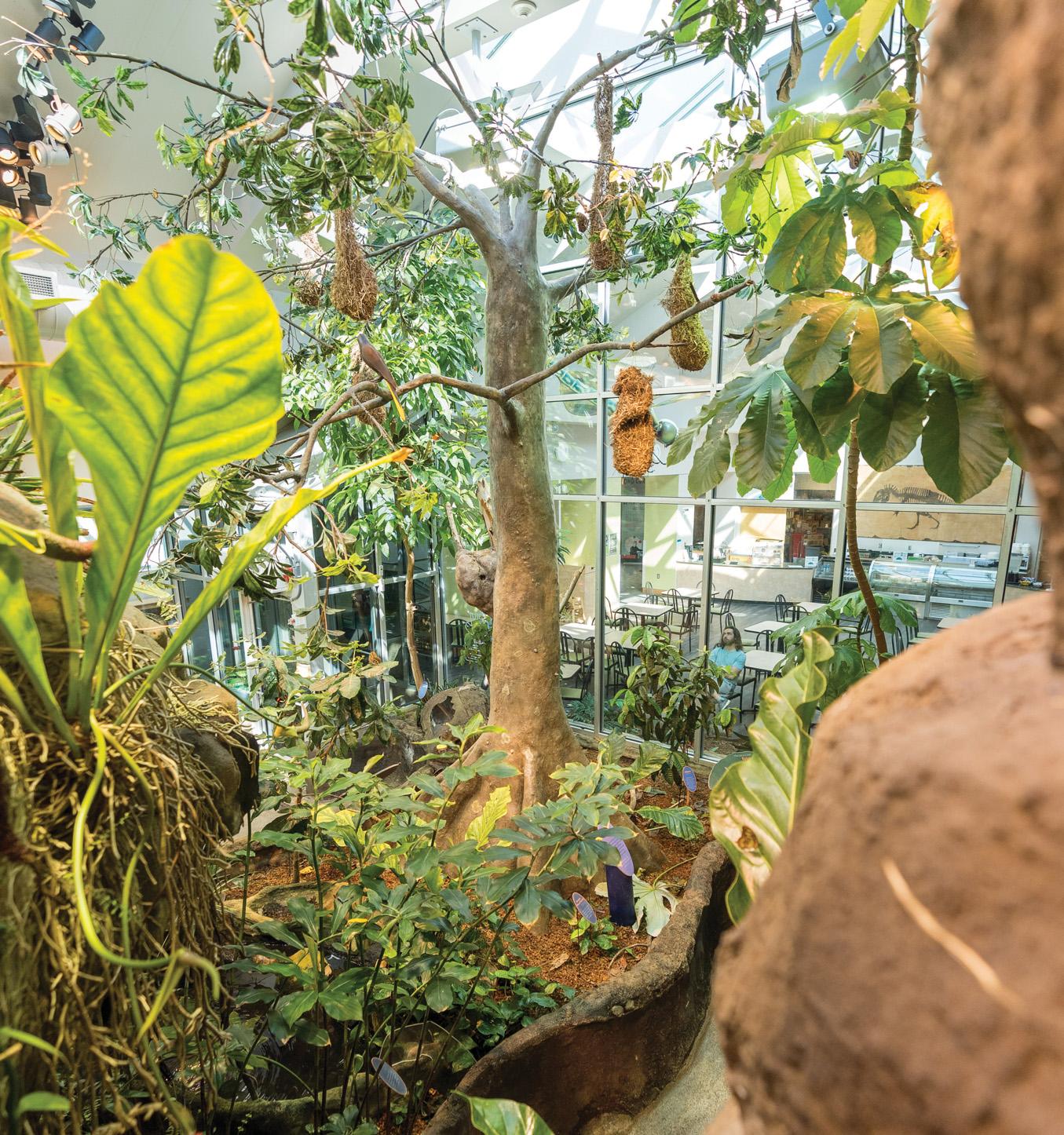

The Living Conservatory on the fourth floor of the North Carolina Museum of Natural Sciences is a visitor favorite, an exhibit that immerses guests in a Central American tropical dry forest filled with animal and plant life. Inside the glass conservatory, visitors can encounter animals and plants like nowhere else in the museum.
But the popular exhibit — the museum estimates that 100,000 visitors came through per year at its peak — has been mostly closed since the onset of the pandemic, due to safety protocols and staffing issues. This May, however, it will reopen for regular visiting hours, and all of the butterflies, turtles, tarantulas, snakes and even the two-toed sloth will be there.
“A lot of our guests have visited before or have heard about the butterflies and come looking for them specifically,” says the museum’s acting director of living collections, Jeff Mette. “I think the free-flying aspect is a big appeal.”
The Living Conservatory is, in a sense, a giant butterfly house. Visitors can lean down to watch as a striking blackand-orange hecale longwing butterfly sucks nectar from the star-shaped blooms of a bright-pink penta plant. They can see the delicate movements of chocolate page butterflies and red postman longwings. Species native to Central and South America live in this conservatory in the heart of downtown Raleigh, exemplifying North Carolina’s connection to the tropics through migration and shared species.
Since most butterflies live only a short time — only a few weeks in this environment — stocking the Living Conservatory is a constant task for Andy Kauffman, who started as an intern at the NCMNS 21 years ago and is now its curator. The butterfly pupae, produced at a breeding facility in Costa Rica, are carefully packaged and shipped to Denver, then on to North Carolina. It is an expedient twoto three-day trip, with vigilance at each step to prevent the introduction of agricultural pests (hence the double-lock doors of the conservatory that prevent the butterflies from getting out into the world).
Kauffman designed special metal rails that hold replaceable foam strips to which the butterfly pupae are pinned, and guests can watch the butterflies emerge through a plexiglass frame. “To move the newly emerged butterflies, I gently transfer them to a small mesh cage by carefully capturing each one with a cupped hand, or by gently grasping their thorax between my thumb and forefinger. It depends on the size of the butterfly,” says Kauffman. After the butterflies are transferred from the emergence chamber to the mesh cage, he records the number of butterflies collected and releases them into the conservatory.
Not every pupa makes it out of its chrysalis. But, says Kauffamn, that’s not reason for sadness: Each one has already had a whole life as a caterpillar, feeding and growing as it builds up to the reproductive stage, that fleeting and spectacular stint as a butterfly. “I hope that people leave the conservatory inspired to get outside and explore, but also
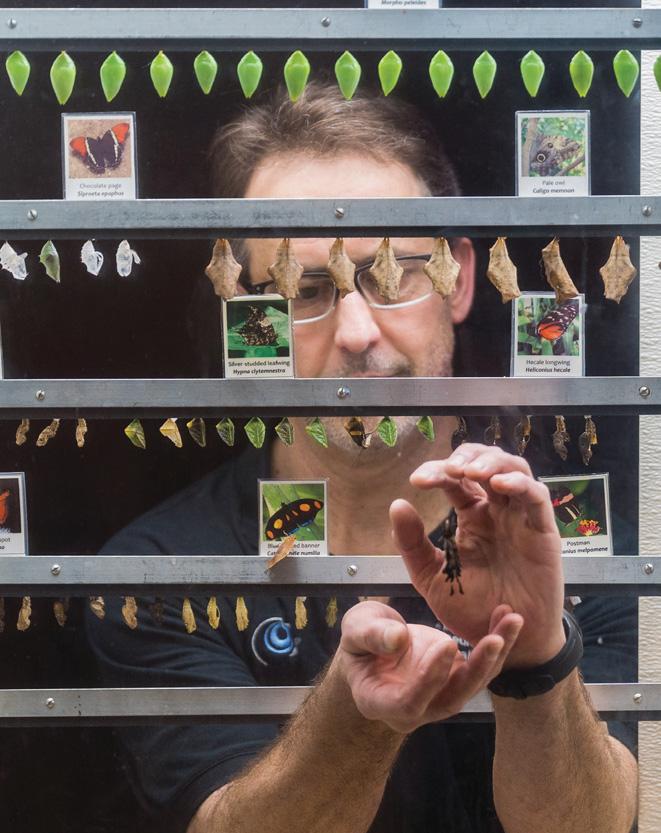




CATCH & RELEASE

Clockwise from top left: Andy Kauffman captures a butterfly to move it into the Living Conservatory; a postman butterfly on a leaf; various butterflies being released, a hecale longwing butterfly, a silver-studded leafwing.







with a greater appreciation for the natural world,” he says. Many come for the butterflies, but for Mette, the draw of the Living Conservatory is harder to spot: He favors the fish — Central American cichlids and Eastern mosquitofish — circling the 200-gallon pond in the exhibit. The cichlids, native to brackish water, fast-moving rivers and bays, are often selectively bred for aquariums due to their brilliant streaks of neon markings. Another streak of neon is in the conservatory too, this one nestled under leaves and bark: a Stuart’s milk snake. (Don’t worry — the snake is enclosed in its own terrarium.) Guests may spot ornate wood turtles making their way into the pond or nibbling on bowls of turtle salad. There is a fuzzy “Brazilian Black” tarantula (Grammostola pulchra) securely locked at eye level inside a plexiglass faux-rock enclosure. Not limited to animals, the life in the conservatory also features a cashew tree, vanilla orchid and pineapple plant, all exemplary of the Central and South American tropical climate the conservatory replicates.
“I hope that people leave the conservatory wanting to learn more about something they experienced in the room.”
— Andy Kauffman
Kauffman never tires of seeing guests’ expressions when they first step inside his exhibit, when a butterfly lands on their shoulder, or they look up to see the sloth moving overhead. “I think the biggest draw is the fact that it is an immersion exhibit,” he says, “where one can walk amid free-flighted butterflies in a tropical setting.”
The two-toed sloth, who slowly traverses ropes and noshes on sweet potatoes high in the corner, is the unexpected star of the show. He would live among these plants and animals up in the canopies of a tropical rainforest, and comfortably lives among them here. He is golden-haired and slovenly, spending much of his days resting in his hide box at the top of the exhibit. Both nocturnal and shy, the sloth emerges most often in the evenings to retrieve vegetables from his food dish, which he often takes back up to his box to eat in private. He has been carefully trained — hand-fed and petted by Kauffman — to help him remain comfortable with humans, for when he requires care from one of the museum’s in-house veterinarians.
“I hope that everyone who visits the Living Conservatory has a memorable experience and learns something new about the plants, animals and habitats there,” Mette says, “but more than new answers, I would like them to leave with new questions — about what they want to learn next.”



WALTER’s roundup of gatherings, celebrations, fundraisers and more around Raleigh.
86 An Evening of Art with Beverly McIver and Liza Roberts
89 Big Night In for the Arts 90 Wake Tech IGNITE
91 Allyship in Hospitality 91 Patrick Dougherty Art Installation
92 Dreamville Festival 93 I Heart Purim: An Intergalactic Gala
94 Skate Raleigh Groundbreaking 94 Designed for Joy Bag Launch
To have your event considered for The Whirl, submit images and information at waltermagazine.com/submit-photos
On March 23, WALTER hosted renowned visual artist Beverly McIver in conversation with Liza Roberts, the author of the book Art of the State and WALTER’s founding editor. The event took place at Raleigh’s Contemporary Art Museum downtown, and was a preview to McIver’s solo exhibition there, Screaming Out Loud, which will run through September 10. It showcases decades of McIver’s work, some of which has never been displayed before.
Guests mingled over cocktails and hors d’oeuvres in CAM’s lounge before settling in for the artist talk inside the main gallery. McIver, who is featured in Roberts’ book, spoke about the inspiration for her


work, her journey as an artist and her processes. After the two spoke, audience members were able to ask questions, as well as have books and exhibition material signed by Roberts and McIver.
Thank you to presenting sponsor Bank of America Private Bank and supporting sponsor Fink’s Jewelers for making the evening a success. Thank you also to event partners Green Front Furniture, The Country Bookshop, Attended Events and AlphaGraphics. Under the Oak Catering served small bites and Westgate Wine and NoDa Brewing served beverages.
Special thanks to Craven Allen Gallery in Durham and the Turner Carroll Gallery in Santa Fe, which represent McIver locally and nationally.






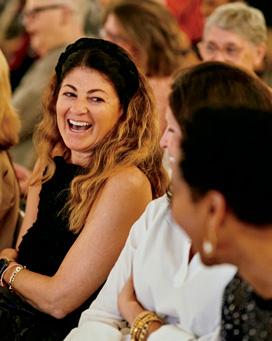


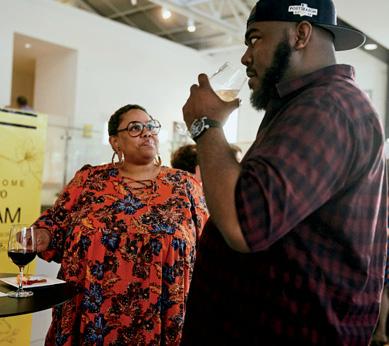









The third annual Big Night In for the Arts raised over $170,000 for the Triangle arts community. The event, presented by United Arts of Wake County, Durham Arts Council, Chatham Arts Council and Orange County Arts Commission, was broadcast on WRAL on March 9 with performances from Chatham Rabbits, Beth Leavel and more. Arts supporters gathered at The Mayton Inn to watch the show together and enjoy a special performance from Rissi Palmer.








WAKE TECH IGNITE
More than 750 local business leaders and influencers gathered March 1 at the Raleigh Convention Center for Wake Tech IGNITE, an annual event to showcase the college and its mission of transforming lives. Hosted by the Wake Tech Foundation, this year’s theme was “Wake County Runs on Wake Tech” and showcased how the college strives to serve its neighbors by helping them achieve their dreams.



















sharing STORIES inspiring ACTION
Our signature innovation event returns featuring inspiring workshops and moving talks by local female leaders.
Friday, September 15 at the Umstead Hotel & Spa






On April 1 and 2, J. Cole’s third Dreamville Festival played host to 100,000 total guests with fans traveling from a record-breaking 23 countries across four continents as well as all 50 states. Cole’s Sunday set featured special guest Drake as well as surprise performances from Lil Wayne, 21 Savage and Lil Uzi Vert. North Carolina performers included 9th Wonder, Reuben Vincent and Rapsody.





I PURIM: AN INTERGALACTIC GALA
On March 25, the Friends of the Judaic Art Gallery hosted its 11th I Purim fundraiser, this year themed An Intergalactic Gala. The evening of food, music and entertainment celebrated the Judaic Art Gallery in its 40th anniversary year.


















On March 22, Skate Raleigh officially broke ground on its downtown skatepark project on Dortch Street. Attendees included Raleigh mayor Mary-Ann Baldwin, members of City Council Sig Hutchinson and Mike Conlon, Apex mayor Jacques Gilbert, members of the Skate Raleigh board and local skaters.

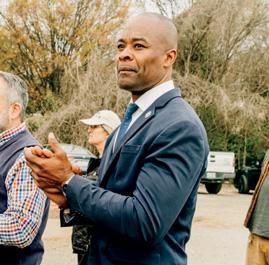



Hear

DESIGNED FOR JOY BAG LAUNCH
Designed For Joy celebrated a new leather handbag line with a launch party in their Warehouse District studio on March 30. Boutiques across the country already sell this new line and a deal with HSN has just been announced.

Take WALTER to go! There’s always something to discover on our website and social media.





10 SPRING COCKTAILS AND DRINKS TO TRY Now on the menu at local establishments: Flower- and herb-forward cocktails and mocktails that take advantage of the warming season. by Emma Deal
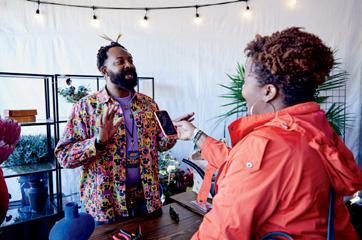
THE SOUTH HAS SOMETHING TO SAY: BACKSTAGE AT DREAMVILLE 2023
In the third year of J. Cole’s immersive music festival, performers reflect on the unique spin N.C. brings to hip hop. by Courtney Napier




Ten months into the pandemic, I squeezed my leg. It felt like pudding in a plastic bag; sourdough and Tiger King had taken their toll. I needed to do something to avoid becoming one with my couch. Alas, there were no bikes for sale and I am way too clumsy for YouTube yoga.
But I had a pair of neglected tennis shoes and a couple of podcasts. So I started walking.
At first, it was just a 10-minute saunter around the neighborhood. Soon that became a 30-minute walk on the Cary Greenway. Then monotony set in: same paths, same houses, same sidewalk cracks. So I tried out the American Tobacco Trail. It’s not far from my neighborhood, and it’s flat. Win-win!
Here’s what I hadn’t heard about the ATT: it’s a gateway trail. Within that first month I had finished the whole trail, from downtown Durham through Chatham County. First, you have coffee shops and bathrooms. But toward the end of the trail you’re out beyond the suburbs — for a novice, that feels like the wild frontier. I’ve got to bring my own water? It’s getting serious!

mile. I switched from podcasts to 1990s hip-hop. Two miles became 4, then 6. I realized longer hikes mean less traffic, which means more of nature’s obstacles. I traded watching birds and trees for stunning vistas of my shoes, rocks and knobby bits of root. Lesson: Pay attention or get humbled real fast.
I traded watching birds and trees for stunning vistas of my shoes, rocks and knobby bits of root.
I craved a real hike. Hello, Eno River! Strut Nation is here in track pants with a water bottle. Within a few months I was paying attention to my time per
Oh, I’ve felt gravity’s cruel embrace more than once. I could write a book called “Falls of the Triangle” without a single mention of water. I’ve taken tumbles at Jordan Lake, Johnston Mill Preserve and Umstead. Most memorable was the time I temporarily forgot snakes existed: I fell while screaming profanities over one slithering along a path at Holden Mill.
Today, I am a changed woman. A real hiker with Merrell boots, a day pack and bagged lunch. (FYI: Orange slices taste just as good now as they did when I was 8.) I wake up early to drive to Raven Rock or Uwharrie. I take note of fellow hikers: Is that moisture-wicking technology? Should I get a microfiber snot rag? Also, here’s a tip: When you scream “What a handsome boy!” to a gentleman walking his pit bull, make sure you replace “boy” with “dog.”
Now I drop things into conversation like, “Oh, I have to wake up at 5 a.m. for a hike,” or “My thighs are burning from Occoneechee Mountain.” I once said to a new mother: “You think your baby is beautiful? Just wait until you see the trailhead at Poe’s Ridge!” (Sorry, Gabby.)
I’m a shell of the couch potato I once was. And I’ve never felt so alive.


















Your children. Your family. Your health. Your well-being. Your place. rom pregnancy and childbirth to mammograms, menopause and more, the care is as compassionate as it is comprehensive. Covering every thing and any thing female from outpatient and inpatient surgery to specialt y and subspecialt y care, and the most advanced technology. After all, when it comes to you, your health and your family, you’re the decision maker. And the decision is clearly WakeMed Women’s.
